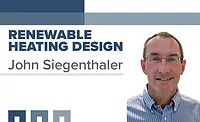Trimming the fat in baseboard-floor heating-domestic hot water system
The Glitch
An installer is asked to provide a system that supplies two zones of fin-tube baseboard and two zones of floor heating. The system also supplies domestic water heating. He selects a mod/con boiler because it’s lighter than a conventional boiler and pipes it as shown in the Glitch drawing above. The primary circulator runs when any of the space-heating zones call for heat.
Can you spot at least five errors in how this system is configured or improvements that would accomplish the same goals with less hardware?
The Fix
A mod/con boiler could be used in this type of system. However, dependingon the design supply water temperature used to size the heat emitters, it may operate in a noncondensing mode at times and, thus, not at peak efficiency. Under partial-load conditions, the boiler’s inlet water temperature might be low enough to allow some condensing mode operation.
Although the installer’s intention was to create a “primary loop,” that’s not what he ended up with. The two high-temperature zones are piped across the loop rather than into pairs of closely spaced tees. The primary circulator also will induce hot water migration into the higher temperature zones due to the head loss around the remainder of the primary loop.
Another problem is the lack of a thermal trap, or spring-loaded check valve, to stop heat migration through the injection risers when the injection pump is off but the “primary circulator” is operating. Although the drop leg in the piping might constitute a trap of sorts, it will not stop heat migration into the injection risers.
To create an effective thermal trap, the pair of tees that connect to the hot-water piping must be at least 18 in. above the pair of tees that connect to the mixed water temperature piping.
From a design perspective, there is no need to create a primary loop in this system. Provided the headers are relatively short and generously sized (flow velocity less than 2 ft. per second with all circulators running), the injection pump can be piped across the headers as shown in the Fix drawing. However, when doing this, be sure the injection pump has a built in check valve.
There also should be purging valves on the return side of all zone circuits and these valves need to be installed in the correct orientation. The Glitch drawing shows them upside down on the return side of the high-temperature zones.
There is no air separator in the Glitch drawing. The Fix drawing shows the air separator installed so flow leaving the boiler passes through it in both space-heating and domestic water-heating modes.
The boiler’s supply temperature sensor is mounted too close to the closely spaced tees. In this position, the mixing between the incoming boiler water and system bypass water is not complete and the temperature has not settled to the final blended value supplied to the distribution system.
Ditto for the supply sensor of the injection mixing controller. The controls will respond to incorrect temperatures.
There is no need for the injection mixing controller to sense boiler return temperature with a mod/con boiler. It can be omitted and the injection controller configured to ignore this functionality.
Finally, a ball valve is not a good choice for balancing the return injection riser. A globe valve or other valve specifically intended for balancing should be used.
These corrections are shown on the Fix drawing above.
Looking for a reprint of this article?
From high-res PDFs to custom plaques, order your copy today!






